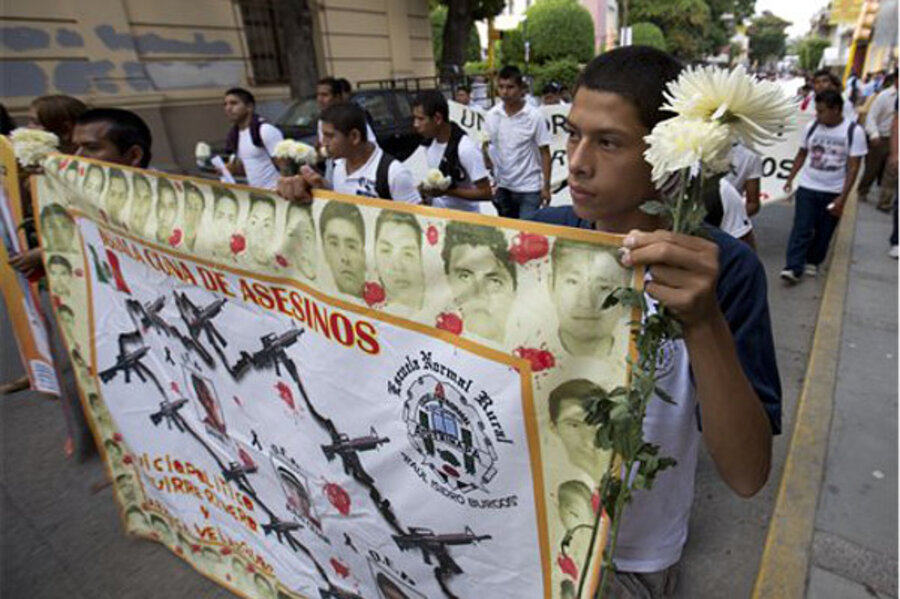Mexican prosecutor: Missing students not in mass graves
Loading...
| CHILPANCINGO, Mexico
Authorities testing remains found in nine mass graves in southern Mexico have yet to find any of 43 teachers college students who disappeared after a confrontation with police, security officials said Tuesday.
None were among 28 bodies, some badly burned, that were unearthed a week after the Sept. 26 attack, Attorney General Jesus Murillo Karam said.
Forensic investigators continued to test other remains and announced the discovery of 10th mass grave Tuesday.
An additional 14 police officers have been arrested and confessed to participating in the disappearance, Murillo Karam said, bringing the total number of detainees to 50.
The 14 are from the police force of Cocula, a town neighboring Iguala, where the confrontation took place in the southern state of Guerrero. Both the mayor and police chief of Iguala are fugitives and accused of links to the local drug cartel, Guerrero Unidos, believed to have worked with police in disappearing the students.
The gang controls drug routes in Guerrero and Morelos states.
Murillo Karam said that officials had yet to identify the masterminds or a motive in the attack, but that the collusion might have gone beyond just one town.
"There's a connection. We will determine if it was coordination or subordination, but it's clear to me that they were working together," he said of police and drug traffickers in the area.
Police opened fire on about 100 students who had hijacked buses to return to campus after arriving in Iguala to pass the hat for their school. Teachers college students are known throughout Mexico for using radical tactics to raise money and spread their leftist philosophy.
Six people were killed, 25 wounded and dozens of students rounded up by police. There has been no sign of the missing in nearly three weeks, leading investigators to comb the clandestine burial sites outside of Iguala, where drug cartels are believed to dump their enemies.
On Tuesday, Guerrero Gov. Angel Aguirre said many of the bodies at the first site appeared to have been buried for some time, suggesting they belonged to earlier victims of criminal gangs.
"Some of them are not recent, some are from months ago," Aguirre told MVS radio.
One forensic expert, who works with federal investigators, said identification is an arduous process that takes time. Charred remains like those recovered at the first mass graves can leave very little DNA for testing.
"If a bone is burned at more than 300 degrees, it's almost impossible to identify because the collagen is burned. Because of that, criminal organizations started to adopt that technique," said Jorge Arturo Talavera, head of the bio-archaeology team at the Mexico's National Institute of Anthropology and History.
He said the way the remains are exhumed also can affect identification. If they're pulled out in a hurried manner, other identifying articles like jewelry or teeth get discarded.
Hundreds of teachers, students and relatives of the missing marched to the center of the state capital, Chilpancingo, on Tuesday, taking a much more solemn tone after a night of angry protests and vandalism that badly damaged the state capital building.
They lined up in silence as organizers passed out white flowers. Some carried candles with a sprawling billboard offering a 1 million peso ($75,000) reward for information.
On Monday, protesters demanding to know the whereabouts of the missing smashed windows at the state capital building complex in Chilpancingo, 132 miles (212 kilometers) south of Mexico City, and set fire to some of the buildings.
Students from the school and local teachers blockaded the capital complex, pelting it with sticks, rocks and Molotov cocktails. The finance secretary of Guerrero state said six buildings were affected.
Also Tuesday, an alleged leader of the Guerreros Unidos killed himself during a confrontation with Mexican security forces Tuesday. Federal forces were carrying out an operation to capture Benjamin Mondragon, or "Benjamon," when a gunbattle broke out, National Security Commissioner Monte Alejandro Rubido said.
Mondragon killed himself as he was about to be arrested, Rubido said, though he had no details on how.
The official said it was unclear whether Mondragon was involved in the students' disappearances.
President Enrique Pena Nieto said the disappearances "are without doubt a topic that will lead the Mexican government at all levels to take actions that will prevent events like those in Iguala from ever occurring again." He said the government "will strengthen institutions, especially those involved in law enforcement, so that they act with greater reliability and efficiency."
___
Associated Press writer E. Eduardo Castillo reported this story in Mexico City and Christopher Sherman reported in Chilpancingo.







